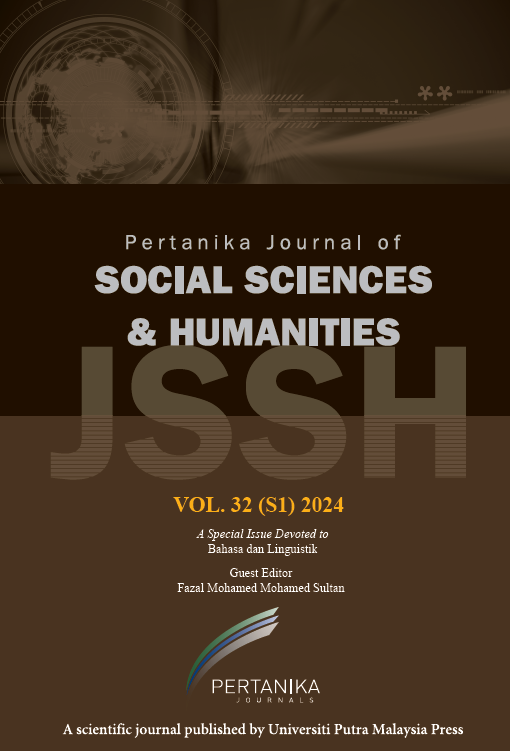PERTANIKA JOURNAL OF SOCIAL SCIENCES AND HUMANITIES
e-ISSN 2231-8534
ISSN 0128-7702
J
J
Pertanika Journal of Social Science and Humanities, Volume J, Issue J, January J
Keywords: J
Published on: J
J
-
Abidin, M. K. Z., Taib, F. S. M., & Nor, S. M. (2017). Distribution and habitat selection of the Asian Openbill (Anastomus oscitans) in Peninsular Malaysia. Malayan Nature Journal, 69(3), 169-181. https://doi.org/10.5281/ZENODO.4005270
-
Ali, N. I. M., Ibrahim, N. I., Aiyub, K., & Kasavan, S. (2020). Pelaksanaan amalan pertanian baik (GAP) dalam kalangan pesawah padi di Sekinchan, Sabak Bernam, Selangor [Implementation of good agricultural practices (GAP) among paddy farmers in Sekinchan, Sabak Bernam, Selangor]. Geografia, 16(3), 247-262. https://doi.org/10.17576/geo-2020-1603-18
-
Arazmi, F. N., Ismail, N. A., Daud, U. N. S., Abidin, K. Z., Nor, S. M., & Mansor, M. S. (2022). Spread of the invasive Javan myna along an urban-suburban gradient in Peninsular Malaysia. Urban Ecosystems, 25(3), 1007-1014. https://doi.org/10.1007/s11252-022-01216-9
-
BirdLife International. (2016). The IUCN Red List of Threatened Species 2016. https://dx.doi.org/10.2305/IUCN.UK.2016-3.RLTS.T22697651A93627701.en
-
BirdLife International. (2022). Species Factsheet: Mycteria cinerea. http://www.birdlife.org
-
Callaghan, C. T., & Gawlik, D. E. (2015). Efficacy of eBird data as an aid in conservation planning and monitoring. Journal of Field Ornithology, 86(4), 298-304. https://doi.org/10.1111/jofo.12121
-
Chuah, B. K. (2013, January 22). Malaysia: Birder’s instinct pays off. New Straits Times. https://wildsingaporenews.blogspot.com/2013/01/malaysia-birders-instinct-pays-off.html?m=1
-
Darren, H. J. A., Ismail, M. H., Muharam, F. M., & Alias, M. A. (2021). Evaluating the impacts of land use/land cover changes across topography against land surface temperature in Cameron Highlands. Plos One, 16(5), Article e0252111. https://doi.org/10.1371/journal.pone.0252111
-
Ismail, A., & Rahman, F. (2012). An urgent need for Milky Stork study in Malaysia. Pertanika Journal of Tropical Agricultural Science, 35(3), 407-4012.
-
Ismail, A., & Rahman, F. (2016). Current status of the Milky Stork re-introduction programme in Malaysia and its challenges. Tropical Life Sciences Research, 27(2), 13-24. https://doi.org/10.21315/tlsr2016.27.2.2
-
Ismail, A., Rahman, F., Kin, D. K. S., Ramli, M. N. H., & Ngah, M. (2011). Current status of the Milky Stork captive breeding program in Zoo Negara and its importance to the stork population in Malaysia. Tropical Natural History, 11(1), 75-80.
-
IUCN. (2021). The IUCN Red List of Threatened Species. Version 2021. https://www.iucnredlist.org
-
IUCN. (2022). The IUCN Red List of Threatened Species. Version 2022. https://www.iucnredlist.org
-
Jabatan Pertanian Semenanjung Malaysia. (2021). Booklet Statistik Tanaman (Sub-Sektor Tanaman Makanan) 2021 [Crop Statistics Booklet (Food Crop Sub-Sector) 2021]. http://www.doa.gov.my/index/resources/aktiviti_sumber/sumber_awam/maklumat_pertanian/perangkaan_tanaman/booklet_statistik_tanaman_2020. [25.08.2021-30.08.20
-
Koli, V. K., Yaseen, M., & Bhatnagar, C. (2013). Population status of Painted stork Mycteria leucocephala and Black-headed Ibis Threskiornis melanocephalus in southern Rajasthan, India. Indian Birds, 8(2), 39-41.
-
Low, B. W., Lim, K. S., Yap, F., Lee, T. K., Lim, K. C., & Yong, D. L. (2013). First record of the Asian Openbill, Anastomus oscitans (Aves: Ciconiidae) in Singapore, with notes on foraging and dispersive movements. Nature in Singapore, 6, 25-29.
-
Mansor, M. S., Halim, M. R. A., Abdullah, N. A., Ramli, R., & Cranbrook, E. O. (2020). Barn swallows Hirundo rustica in Peninsular Malaysia: Urban winter roost counts after 50 years, and dietary segregation from house-farmed swiftlets Aerodramus sp. Raffles Bulletin of Zoology, 68, 238-248. https://doi.org/10.26107/RBZ-2020-0021
-
Mansor, M. S., Ramli, R., & Sah, S. A. M. (2015). The foraging tactics of Chestnut-winged babbler (Stachyris erythroptera) and Abbott’s babbler (Malacocincla abbotti) in a lowland rainforest, Malaysia. Sains Malaysiana, 44(5), 687-692.
-
Rahman, F., Ismail, A., Omar, H., & Hussin, M. Z. (2017). Exposure of the endangered Milky Stork population to cadmium and lead via food and water intake in Kuala Gula Bird Sanctuary, Perak, Malaysia. Toxicology Reports, 4, 502-506. https://doi.org/10.1016/j.toxrep.2017.09.003
-
Rahman, F., Ismail, A., & Yusof, S. (2014). Metals contamination in the foraging area of Milky Stork: Evidence of anthropogenic inputs in the aquatic environment of Kuala Gula, Malaysia. Toxicological & Environmental Chemistry, 95(9), 1499-1505. https://doi.org/10.1080/02772248.2014.892941
-
Robinson, J., & Cranswick, P. (2003). Large-scale monitoring of the effects of human disturbance on waterbirds: A review and recommendations for survey design. Ornis Hungarica, 12(13), 199-207.
-
Samsi, A. N., Asaf, R., Santi, A., & Wamnebo, M. I. (2017). Gastropods as a bioindicator and biomonitoring metal pollution. Aquacultura Indonesiana, 18(1), 1-8. http://dx.doi.org/10.21534/ai.v18i1.42
-
Sullivan, B. L., Aycrigg, J. L., Barry, J. H., Bonney, R. E., Bruns, N., Cooper, C. B., Damoulas, T., Dhondt, A. A., Dietterich, T., & Farnsworth, A. (2014). The eBird enterprise: An integrated approach to development and application of citizen science. Biological Conservation, 169, 31-40. https://doi.org/10.1016/j.biocon.2013.11.003
-
Tan, C. L., & Murali, R. S. N. (2013, January 17). Malaysia not out of stork. The Star. https://www.thestar.com.my/news/nation/2013/01/17/malaysia-not-out-of-stork
-
Zakaria, M. A., & Nor, S. M. (2019). Population estimate of painted stork (Mycteria leucocephala) in three main breeding sites Peninsular Malaysia. In AIP Conference Proceedings (Vol. 2111, No. 1, p. 060005). AIP Publishing LLC. https://doi.org/10.1063/1.5111267
ISSN 0128-7702
e-ISSN 2231-8534
Recent Articles




